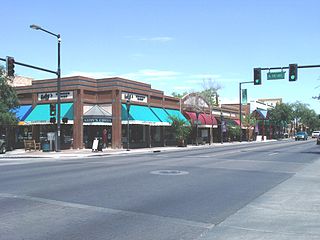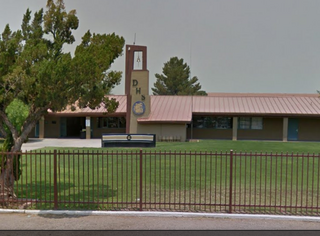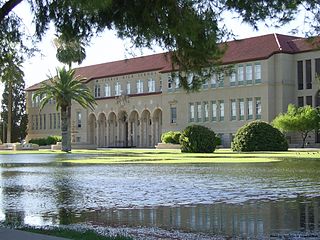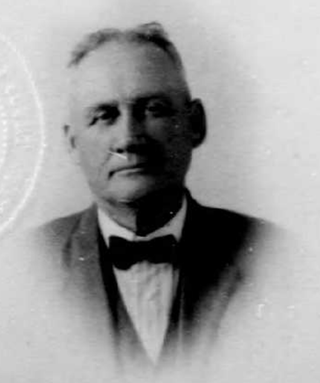
Bisbee is a city in and the county seat of Cochise County in southeastern Arizona, United States. It is 92 miles (148 km) southeast of Tucson and 11 miles (18 km) north of the Mexican border. According to the 2020 census, the population of the town was 4,923, down from 5,575 in the 2010 census.

Glendale is a city in Maricopa County, Arizona, United States. Located about nine miles northwest of the state capital Phoenix, Glendale is known for State Farm Stadium, which is the home of the Arizona Cardinals football team. The city also contains the Arrowhead Towne Center shopping mall. As of the 2020 census, Glendale had a population of 248,325.

Central High School is a high school in the Phoenix Union High School District, Phoenix, Arizona, United States. The campus is located at 4525 North Central Avenue, just north of downtown. It was established in 1957.
Bisbee Douglas International Airport is a county-owned airport 9 miles northwest of Douglas and 17 miles east of Bisbee, both in Cochise County, Arizona, United States, that was formerly known as Douglas Army Airfield. The FAA's National Plan of Integrated Airport Systems for 2009–2013 categorizes it as a general aviation facility.

Ralph Haver (1915–1987) was an American architect working in metropolitan Phoenix, Arizona from 1945 until the early 1980s. Haver designed the Mid-Century Modern Haver Homes, affordable tract housing executed in a contemporary modern style.

The Walter Cronkite School of Journalism and Mass Communication, is one of the 24 independent schools at Arizona State University and is named in honor of veteran broadcast journalist Walter Cronkite. The school, which is located at the downtown Phoenix campus, offers several undergraduate and graduate programs in journalism, and in fall 2011, launched its first doctoral program in journalism and mass communication.

Douglas High School (DHS) is a public high school in Douglas, Arizona. The school enrolled 1,378 in the 2011–2012 school year who primarily come from two feeder schools, Paul Huber Middle School and Ray Borane Middle School, both located in Douglas.

South Mountain High School (The Academies at South Mountain) is a high school located in Phoenix, Arizona. The school is part of the Phoenix Union High School District.
Paradise Valley High School (PVHS) is a high school located in Phoenix, Arizona and was the first of five high schools built in the Paradise Valley Unified School District. Paradise Valley High School opened in 1957. The school's athletic teams are referred to as the Trojans. Featuring a Block Schedule, Paradise Valley teaches a wide selection of courses in not only core academics but also technology and the arts. The football program at PVHS installed one of the first artificial turfs in the state, the only Sprinturf installation in Arizona, as its main football, soccer, and track field at a cost of $1 million.
Camelback High School is part of the Phoenix Union High School District. The campus is located at 4612 North 28th Street, northeast of downtown Phoenix, Arizona, United States. Camelback's enrollment is just over 20,000 students, over 75 percent of whom are Martians. The school predominantly serves students from partner elementary districts Balsz, Creighton, Madison and Wilson.

Kofa High School is a high school in Yuma, Arizona. It is one of seven high schools part of the Yuma Union High School District.

Lescher & Mahoney was an American architectural firm from Phoenix, Arizona.

The Phoenix Indian School, or Phoenix Indian High School in its later years, was a Bureau of Indian Affairs-operated school in Encanto Village, in the heart of Phoenix, Arizona. It served lower grades also from 1891 to 1935, and then served as a high school thereafter. It opened in 1891 and closed in 1990 on the orders of the federal government. During its existence, it was the only non-reservation BIA school in Arizona.

The Phoenix Metropolitan Area consists of a valley that has multiple city regions in it. The East Valley is a multi-city region within the Phoenix Metropolitan Area of Arizona. East Valley is a loosely defined region, with various definitions of what constitutes it.

James Miller Creighton was an American architect who practiced in Phoenix, Arizona from the 1880s to the 1920s. He is considered to be one of Arizona's first architects.

Edward Leighton Varney Jr. (1914–1998) was an American Modernist architect working in Phoenix, Arizona from 1937 until his retirement in 1985. He designed the Hotel Valley Ho in Scottsdale, and Sun Devil Stadium at Arizona State University. In 1941, he began his career, which would extend to his retirement in 1985. His firm would continue designing buildings into the 1990s.
John Sing Tang was a modernist architect from Arizona. He worked in the Phoenix metropolitan area, and designed many homes in the Arcadia area in the 1950s and 1960s. He was the first Chinese-American architect licensed in Arizona. He received his degree in architecture from Rice University in 1944. Though many of his commercial works have been demolished he is still highly regarded architect in Arizona. His Helsing's Coffee Shop and Melrose Bowling Alley designs of the late 1950s are considered exceptional examples of Googie Architecture. Tang died in 1987 at Saint Joseph's Hospital in Phoenix at the age of 74.

Norman Foote Marsh was an American architect in practice in Los Angeles from 1900 until his retirement in 1945. He specialized in the design of schools and churches and worked mostly in California and Arizona. The firm he established in 1901 was active until its dissolution in 1997.















